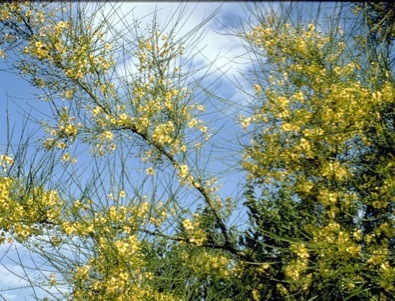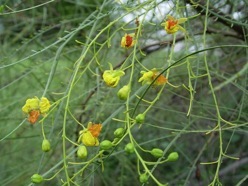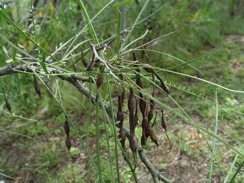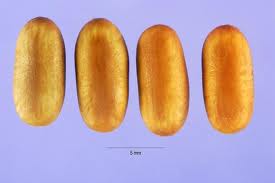Parkinsonia aculeata’s Thorny Past
As foragers we are indebted to past writers and at the same time constrained by them.
People who chronicled how Native Americans used food brought a lot of attitudinal baggage with them even as professionals. They would put food and activities into different categories that can leave us confused all these years later.
A good example is the Parkinsonia genus, with three species represented. One botanist will report that for one tribe a species would be a staple, another would report the same species was a famine food. Yet another will report it was eaten green and raw, another cooked until nearly burnt.
A few hundred years later we just don’t know why the reports vary. It could have been the botanist, or sometimes non-botanist reports. It could have been the time of year, or the weather that year. It could have been a mistake. And it also depended upon whom you found doing what. Even within a small group of professional foragers you will find multiple ways to make acorns palatable. So we end up knowing the seeds of three species in the genus of 5 to 12 (depending upon who is counting) are edible even if the how is a bit elusive. To confuse things more the Parkinsonias are closely related to the Cercidiums which they can hybridize with and which were also used for food. And… some Parkinsonias are called Cercidiums…. Botanists like to squabble a lot over genus and species names.
Perhaps best known is Parkinsonia aculeata (park-in-soh-NEE-uh ah-kew-lee-AY-tuh, or a-kew-lee-AH-tuh) also called the Jerusalem Thorn. It has no connection to Jerusalem but got its name the same way the Jerusalem artichoke did from corruption of the Spanish/Portuguese word girasol, meaning turning towards the sun. P. aculeata has the greatest range in North America and is a common landscape tree as well as naturally occurring. Oddly, it is favored because it is so spindly. It can be planted in front of a large window and not obscure the view. P. aculeata can be found from South Carolina to Florida and all states west at that latitude to California including Utah then south to as far as Uruguay. It is also found in the Virgins Islands, Puerto Rico, Hawaii, Australia, where it’s a troublesome weed in the northwest territories, as well as dry areas of Africa and Pakistan. (P. microphylla is found in California and Arizona. P. florida is found in those two states plus Nevada.) The edible portion is the seeds, usually cooked sometimes raw.
The Papago Indians used the P. aculeata seeds dry. They sun-dried them for storage and then parched them before eating them. Six tribes used the P. micophylla (aka Cercidium microphyllum.) The Mohave and Yuma parched the seeds until nearly burnt and considered them famine food. The Cocopa ground the dried seeds and used it as mush or to make cakes. The Papago sun-dried them before parching and considered the seeds a staple crop. The Pima ate them raw and the Pima of Gila River ate them raw or boiled. Five peoples used the P. florida (aka Cercidium floridum) the Cahuilla, Cocopa, Mohave, Pima, and Yuma. The Cahuilla and Cocopa dried the beans, ground them into flour, and used the flour to make mush or cakes. The Mohave and the Yuma parched the seeds until almost burnt and viewed them as a famine food. The Pima, however, ate the green pods raw in the summertime.
The genus honors English pharmacist John Parkinson, 1567-1650. Parkinson was a predominant English botanist and apothecary to James I. He was a founding member of the Worshipful Society of Apothecaries and served as the Royal Botanist to Charles I. He’s remembered for his two monumental works, Paradisi in Sole Paradisus Terrestris (Park-in-Sun’s Terrestrial Paradise, 1629) which describes the proper cultivation of plants, and, ‘Theatrum Botanicum (The Botanical Theatre or Theatre of Plants), the most complete and artful English treatise on plants of his time. Aculeata means prickly or thorny, microphylla is tiny leaf and flordium means free-flowering or many flowers. Cercidium, sir-sid-EE-um comes from the Greek word cercidion, base word Kirkis, a weaver’s shuttle, in reference to the pod’s shape like a shuttle. The tree is also called Paloverde which means “green stake.” It is a nitrogen fixer — if you’re a permaculturist — and has numerous medicinal uses among them boiling twigs to ease stomach pain.
Lastly, the Jerusalem Thorn had the fortune of growing in the right place, or we did. The vast majority of ethnobotanical information we have (read what the Native Americans ate and used) comes mostly from the western tribes. That’s because the original settlers in the east had little interest in cataloging what the eastern natives did for the most part. It took a couple hundred years before professionals took interest in such things and by then the western tribes were the ones still in tact. That’s why we know how several tribes used the plant even if the uses contradict.
Green Deane’s “Itemized” Plant Profile
IDENTIFICATION: Small wispy tree or shrub. Flowers one inch wide, 5 petals. Top petal turns from bright yellow to orange as the flower ages. Flowers followed by necklace-like, brown bean pods. Leaves bipinnately compound with 10 to 40 six to nine inch long leaflets, needle-like, green midribs, often quickly shed. Branches spiny, young bark can be green.
TIME OF YEAR: Blooms all year or in warmer months if temperate climate
ENVIRONMENT: Thrives in arid conditions, prefers neither too wet or too dry, with good moisture can become a 30-foot tree.
METHOD OF PREPARATION: Mature beans usually dried then parched. Can be used for mush or cakes. Some native ate the beans raw.






